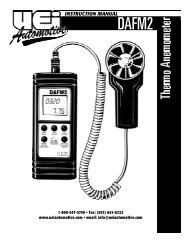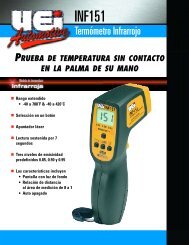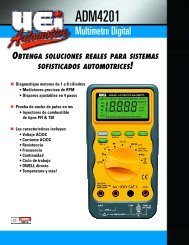Manual - UEi Automotive
Manual - UEi Automotive
Manual - UEi Automotive
Create successful ePaper yourself
Turn your PDF publications into a flip-book with our unique Google optimized e-Paper software.
Continuity ( )<br />
CAUTION!<br />
Turn off power OFF on the test circuit. A beeper tone does not<br />
necessarily mean zero resistance.<br />
1. Set rotary selector to “Ω “ position.<br />
2. Press menu key 2 to select “Continuity” function. “OFL.” is<br />
displayed in the primary display.<br />
3. Insert black lead into “COM” terminal and red lead into<br />
“Ω“ terminal (Fig 6).<br />
4. Touch the test lead proves across the device being tested.<br />
5. The primary display shows “OFL.“ if the diode is good. Any other<br />
readings indicate the diode is resistive or shorted (defective).<br />
Use the table below to determine if the diode is good or bad.<br />
Diode Forward Bias ( ) Reverse Bias ( )<br />
Good 0.4 to 0.9 V OFL<br />
OFL<br />
0.4 to 0.9 V<br />
Bad OFL 1.0 to 3.0 V<br />
1.0 to 3.0 V OFL<br />
0.4 to 0.9 V 0.4 to 0.9 V<br />
OFL<br />
OFL<br />
0.0000 V 0.0000 V<br />
If the resistance of the device is below 70Ω, there is a continuous beep<br />
t o n e .<br />
If the resistance of the device is more than 70Ω, there is no beep tone.<br />
This is useful for checking wiring connections and operation of switches.<br />
Reverse Bias<br />
Forward Bias<br />
Frequency<br />
(Fig 7)<br />
1. Set rotary selector to “Hz” position.<br />
2. Insert black lead into “COM” terminal and read lead into<br />
“Hz” terminal.<br />
Diode (<br />
) Test<br />
(Fig 6)<br />
3. Touch black probe to ground and touch red probe to the<br />
“Signal out” wire on the sensor (Fig 8).<br />
CAUTION!<br />
Turn the power OFF on the test circuit.<br />
1. Set rotary selector to “Ω “ position.<br />
2. Press menu key 3 to select “Diode Test” function. “OFL.“ is<br />
displayed in the primary display.<br />
3. Connect the test leads as shown and observe the digital display.<br />
Normal forward voltage drop (forward biased) for a good silicon<br />
diode is between 0.4 V to 0.9 V. A reading higher than that<br />
indicates a leaky diode (defective). A zero reading indicates a<br />
shorted diode (defective). An “OFL.“ indicates an open<br />
diode (defective) (Fig 7).<br />
4. Reverse the test leads connections (reverse biased) across<br />
the diode.<br />
Ground<br />
Signal Out<br />
Electronic Voltage<br />
ADM5201-MAN (Fig 8) P. 5













